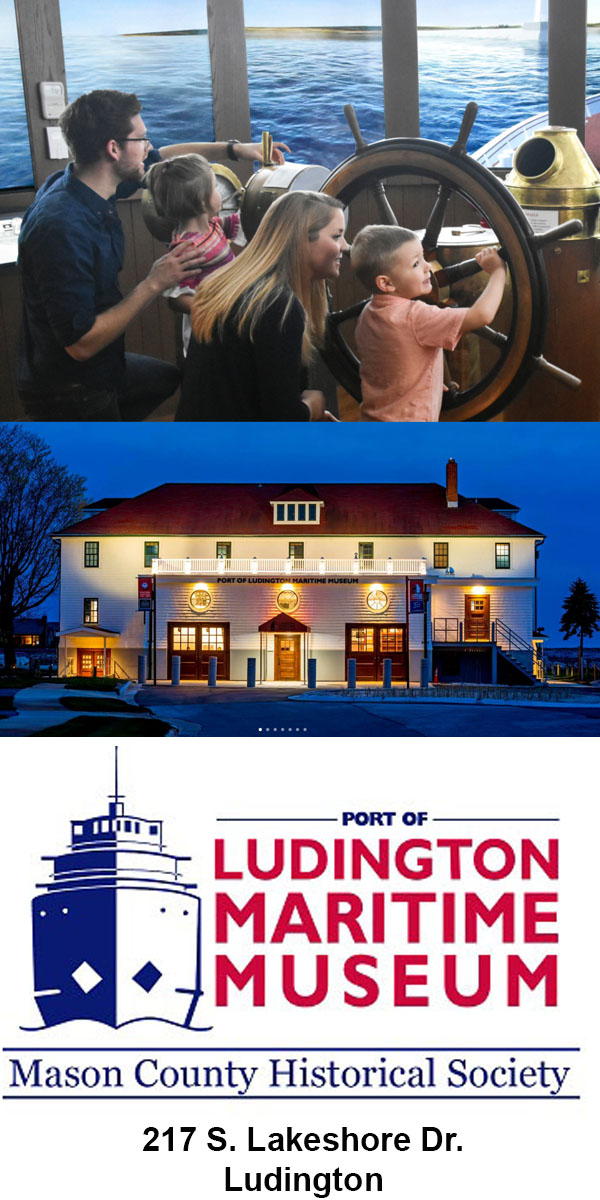
James Ludington
MC History Spotlight: James Ludington
MC History Spotlight is a weekly history column brought to you by Ludington Woods Living and Memory Care. Each week this column features a story from our county’s past.
By Rob Alway, Editor-in-Chief.
The namesake of the city of Ludington was James Ludington, a successful Milwaukee businessman who was born in Carmel, Putnam County, NY on April 18, 1827. His family tree, according to the book “The Story of Ludington,” written by Paul S. Peterson, dated back to the time of the Third Crusade in the 12 century. He was the nephew of Revolutionary War hero Sybil Ludington, who is often compared to Paul Revere.
When Ludington was 11-years-old, his father, Lewis, bought large tracts of timber in Wisconsin. Lewis Ludington later founded Columbus, Wis., located northeast of Madison. James moved to Milwaukee in 1845, when he was 18, to help run his father’s business, Ludington & Co. His success grew from there. He was the treasurer of La Crosse Railroad for two years; president of the Bank of the West in Madison and vice president of the Juneau Bank, according to the book “The History of Manistee, Mason, and Oceana counties,” published in the late 1800s. Ludington also served three terms as a Milwaukee alderman.
Originally, the town known as Ludington was called Pere Marquette. The village of Pere Marquette was settled sometime in the 1840s, mostly along what was then called Main Street, now known as Gaylord Avenue. The attraction was the proximity to Pere Marquette Lake, which at that time did not open into Lake Michigan.
According to “The History of Manistee, Mason, and Oceana counties,” Joseph L. Wheeler entered a portion of the lake fronts in 1840, on Pere Marquette Lake. In 1847, Joseph Boyden acquired 72 acres fronting on Pere Marquette Lake and in 1849, Baird and Bean built a mill on Pere Marquette Lake.
About the same time, in 1847, Charles Mears built a mill at Black Creek, later known as Lincoln (near modern day Lincoln Hills Golf Club on Lincoln Lake in Hamlin Township). “A log house and blacksmith shop were first built.” Mears changed the name in 1861 after Abraham Lincoln was inaugurated as president.
Baird and Bean sold their sawmill to George Farnsworth in 1849 who shortly afterwards sold the mill to George W. Ford, a Manistee lumberman, according to Peterson. Ford’s financial troubles cost him his mill to James Ludington.
Peterson writes that in October 1854, Ford had been introduced to Ludington and his associate, attorney James Mason Loomis. “Ludington and Loomis agreed to lend ford $6,000. In return, they were to supply Ford with the means necessary for him to expand his mill and hire sufficient loggers and mill hands. As part of the deal, Ludington also advanced Ford money to buy certain other lands in his and Loomis’ name. As security, Ford put up his mill, his boarding house, and land. Included as collateral were 400 acres near the mill. Terms of the contact called for Ford to repay $2,000 by January, 1855, three months after the contract had been signed and the remaining $4,000 over the next five years.”
Ford apparently had other debts with Ludington and Loomis, along with others. In 1857, the nation underwent an economic downturn known as “The Panic of 1857” in which many banks and businesses closed and thousands of people lost their jobs. Ford was one of the victims.
Loomis and Ludington sued Ford. In his book, Peterson states that the case was one of the most contentious cases in Mason County history. The court ordered Ford to pay $69,849, which included the original loan and others that Ludington and Loomis had lent Ford, plus 10% interest and the 400 acres of land. The court also awarded Ludington possession of the mill. The two sides reached a settlement. However, 10 years later, Ford sued Ludington, claiming that 40 acres, which were to have been set aside as a homestead for Ford, had been erroneously included in the 400 acres. Ludington’s attorneys eventually acknowledged the error.
The 40 acres were the best land out of the 400 and apparently Ford had already sold the land to another person. It was equivalent to 12 blocks or 120 city lots. bounded by what is now Ludington Avenue on the north, a parallel line between Foster and Danaher streets on the south, on the west by Rath Avenue and on the east by a line running through the middle of the courthouse. It comprised most of the modern Third Ward.
According to a newspaper report in 1920, Ford died a pauper and was buried in an unmarked grave in Lakeview Cemetery.
In 1864, Ludington opened a post office and called it Ludington. David A. Melendy, who had recently come to the area as a bookkeeper for James Ludington was postmaster.
In 1867, Ludington platted 360 acres of land around Pere Marquette and sold lots to individuals, developing the town. He named Ludington Avenue and James Street after himself. He also named several streets after family members: Lewis (father); siblings William, Robert, Charles, Harrison, Emily, Lavinia, and Delia. An online family tree also lists the streets Charles and Amelia
That same year, he built a large commercial building called The Big Store, which sold a variety of goods. He also founded the first newspaper in the village, the Mason County Record.
The sawmill that Ludington acquired developed into an independent entity, called the Pere Marquette Lumber Company, which operated and managed the sawmill and The Big Store. On July 24, 1869, Ludington sold his interests to the company for $500,000. He used a portion of the proceeds to develop the village.
The three-county history book states: “Many people still suppose that the name of the place was changed from Pere Marquette to Ludington at the time the city was incorporated in 1873. Such, however, is not the fact. The township still remains the name of Pere Marquette, under which it was organized, while the name of Ludington dates from the time the post office was established, as stated above, and when the city was incorporated in 1873 it was voted to retain the name. In recognition of this consideration on the part of the people here, Mr. Ludington donated a munificent gift of $5,000 to be expended in county and city public buildings.”
Ludington never married, nor did he ever live in the city of Ludington. History records that his visits to the town were brief and he spent most of his adult life living in hotel rooms in Milwaukee. He died on April 1, 1891 in his residence at Plankinton House Hotel in Milwaukee. He was 63. Ludington is buried in a cemetery in Carmel, NY.
Ludington Woods Assisted Living and Memory Care, 502 N. Sherman St., Ludington, MI 49431; 231-845-6100; www.ludingtonwoods.com.
This story is copyrighted © 2019, all rights reserved by Media Group 31, LLC, PO Box 21, Scottville, MI 49454. No portion of this story or images may be reproduced in any way, including print or broadcast, without expressed written consent.






























.png)


































